The following publications of the author (Dr. R. Klitzing) are available here in a PDF version.
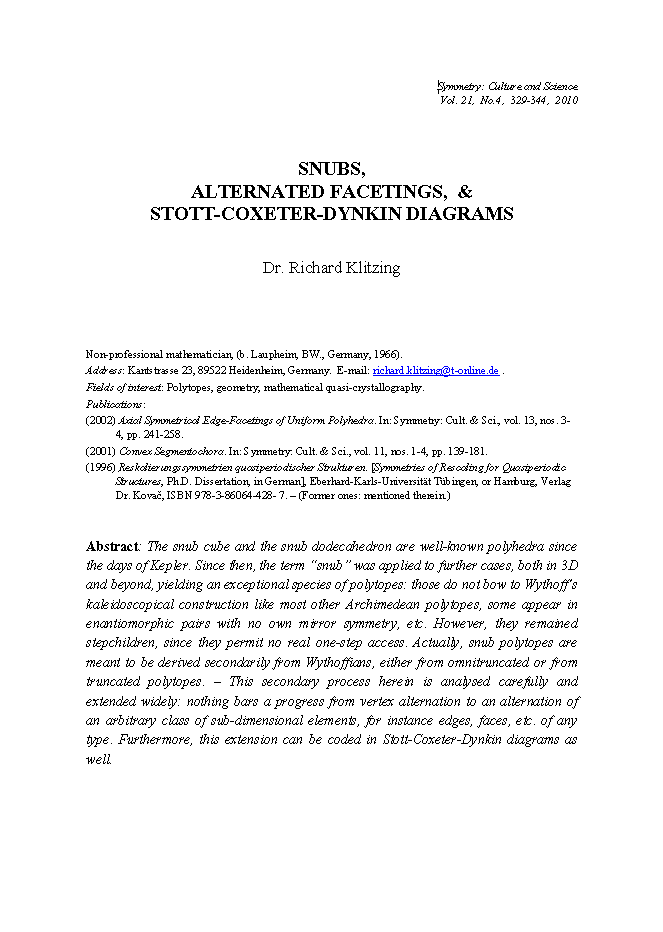
|
|
Snubs, Alternated Facetings, &
Stott-Coxeter-Dynkin Diagrams published at: Symmetry: Culture and Science Vol. 21, No.4, 329-344, 2010 |
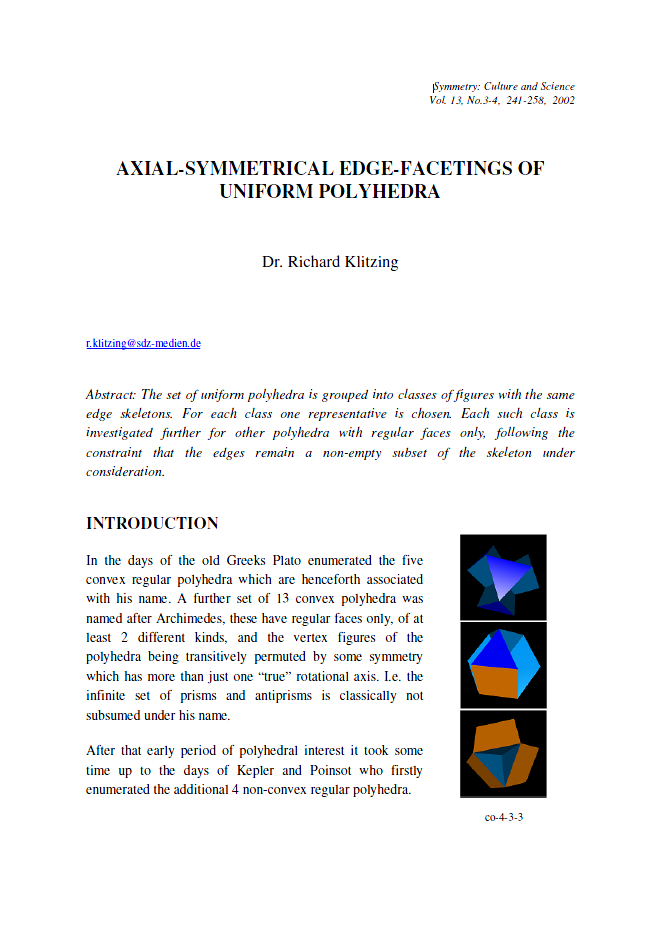
|
|
Axial-Symmetrical Edge-Facetings
of Uniform Polyhedra published at: Symmetry: Culture and Science Vol. 13, No.3-4, 241-258, 2002 2) |
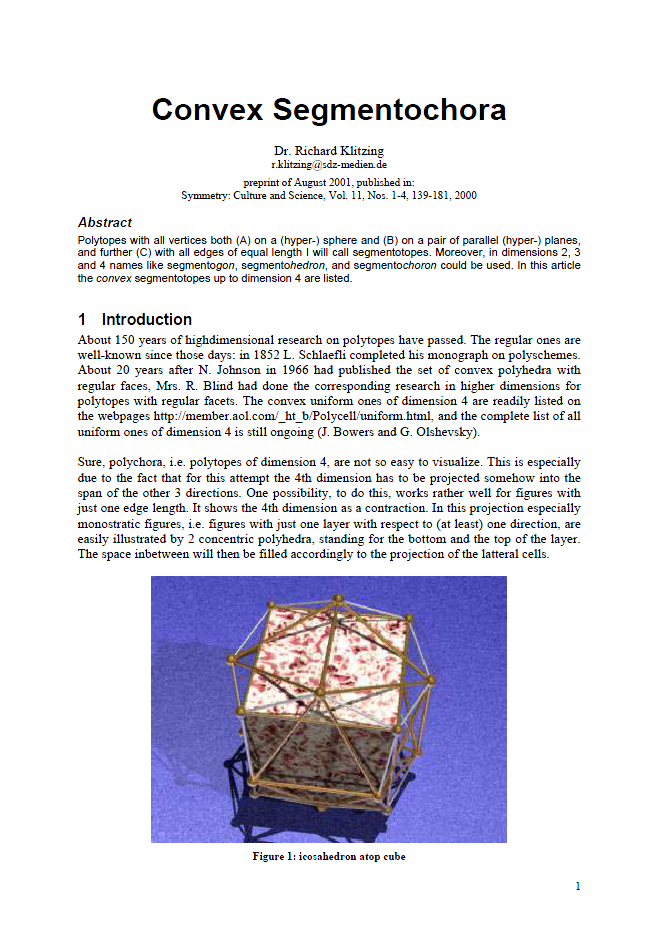
|
|
Convex Segmentochora
published at: Symmetry: Culture and Science Vol. 11, Nos. 1-4, 139-181, 2000 1) |
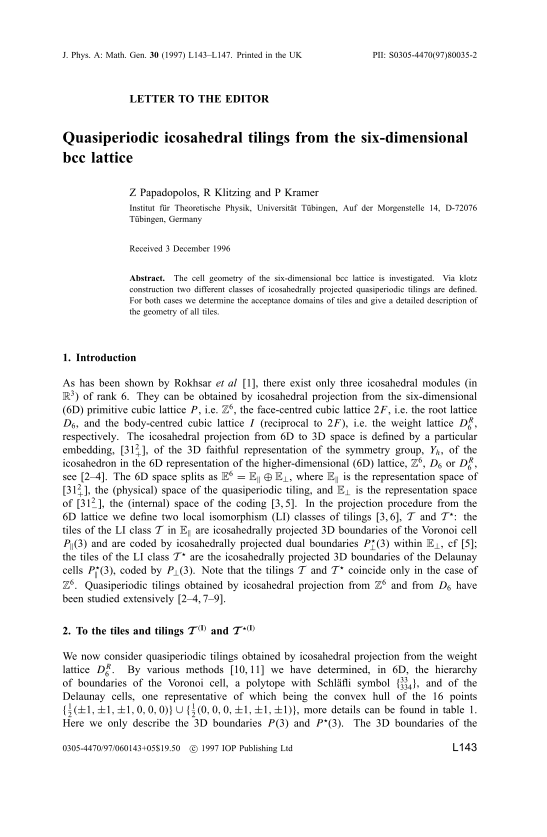
|
|
Quasiperiodic icosahedral
tilings from the six-dimensional bcc lattice authors: Z. Papodopolos, R. Klitzing, P. Kramer published in: J. Phys. A: Math. Gen. 30 No. 6, L143-L147, 1997 |
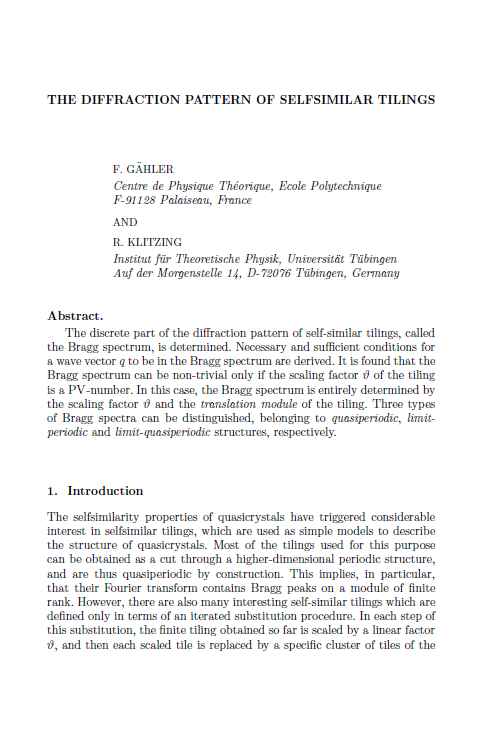
|
|
The Diffraction Pattern of
Selfsimilar Tilings authors: F. Gähler & R. Klitzing published in: The Mathematics of Long-Range Aperiodic Order, ed. R. V. Moody NATO Advanced Study Institute Ser. C, Vol. 489, 141-174, Kluwer 1997 |

|
|
PHD thesis
(german) – no download – |
|
Reskalierungssymmetrien
quasiperiodischer Strukturen published 1996 at: Verlag Dr. Kovač ISBN 978-3-86064-428-7 |

|
|
Substitutional Tilings with
Non-Degenerate Limit Translational Modules, but with Vanishing Bragg Intensities authors: R. Klitzing published in: Proc. of the 5th Int. Conf. on Quasicrystals eds. C. Janot & R. Mosseri 88-91, 1995 World Scientific |
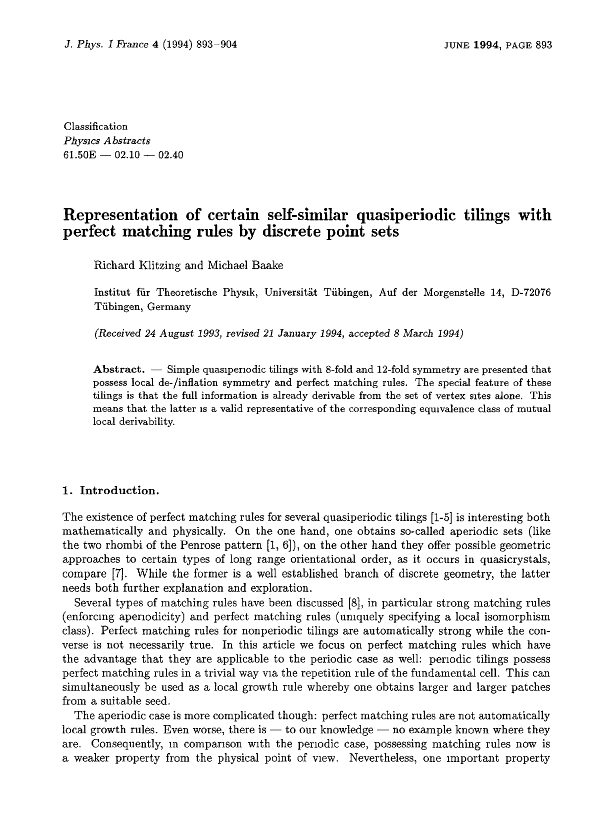
|
|
Representation of certain
self-similar quasiperiodic tilings with perfect matching rules by discrete point sets authors: R. Klitzing & M. Baake published in: J. Phys. I, France Vol. 4, 893-904, 1994 |

|
|
Classification of
Local Configurations in Quasicrystals authors: M. Baake, S.I. Ben-Abraham, R. Klitzing, P. Kramer, M. Schlottmann published in: Acta Cryst, Sect. A50 Vol. 5, 553-566, 1994 |
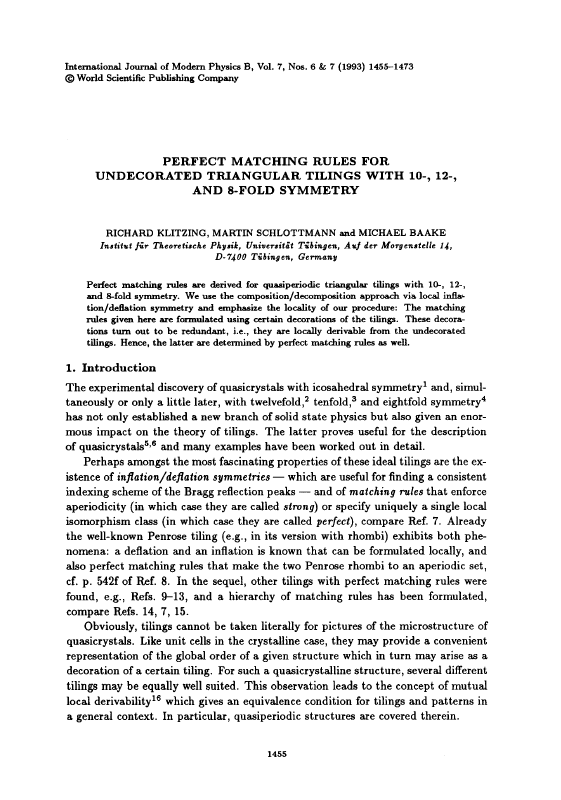
|
|
Perfect Matching Rules for
Undecorated Triangular Tilings with 10-, 12- and 8-fold Symmetry authors: R. Klitzing, M. Schlottmann, M. Baake published in: Int. J. Mod. Phys. B, Vol. 7, Nos. 6 & 7 1455-1473, 1993 World Scientific |
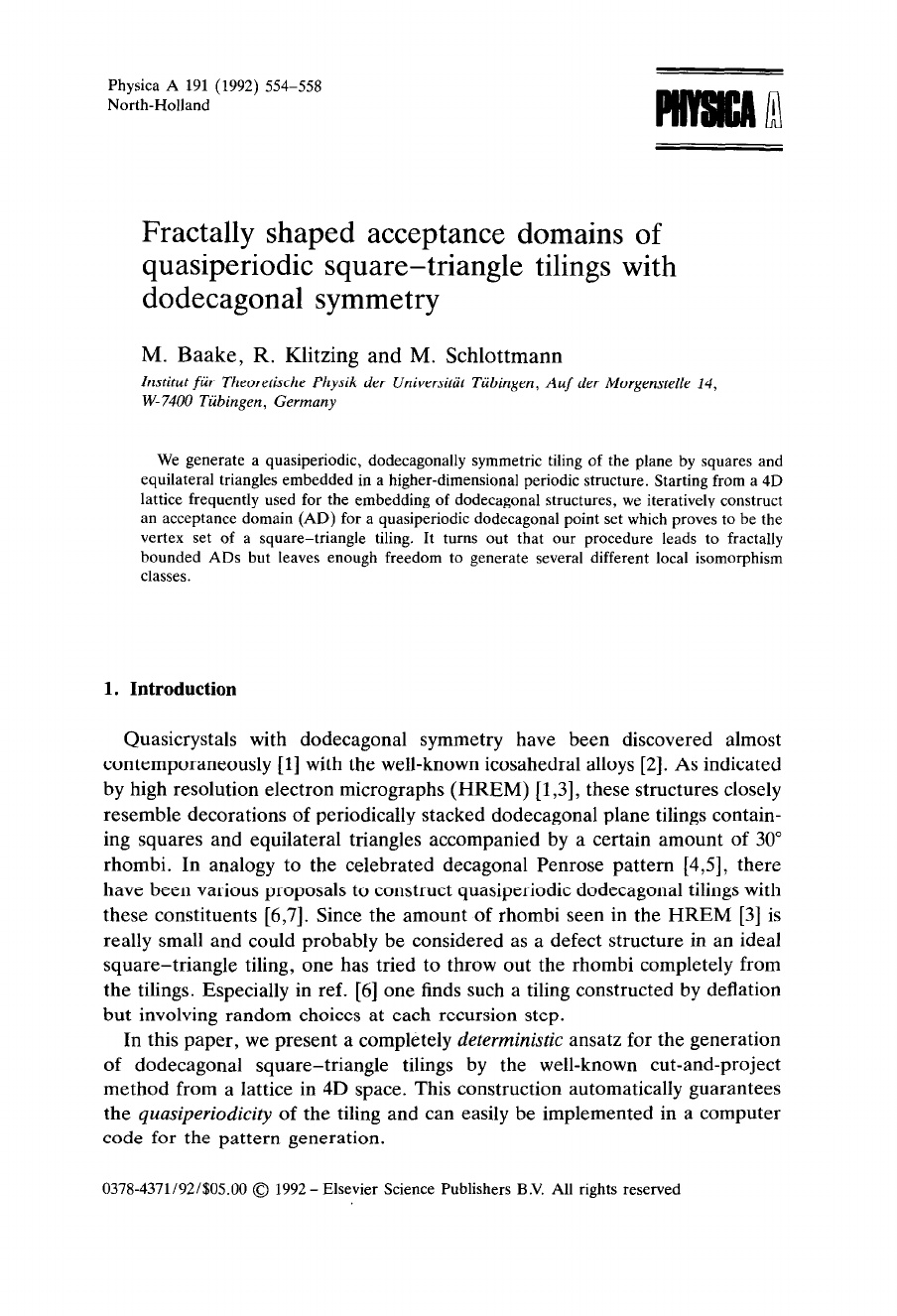
|
|
Fractally shaped acceptance
domains of quasiperiodic square-triangle tilings with dodecagonal symmetry authors: M. Baake, R. Klitzing and M. Schlottmann published in: Physica A, 191, 554-558, 1992 North-Holland |
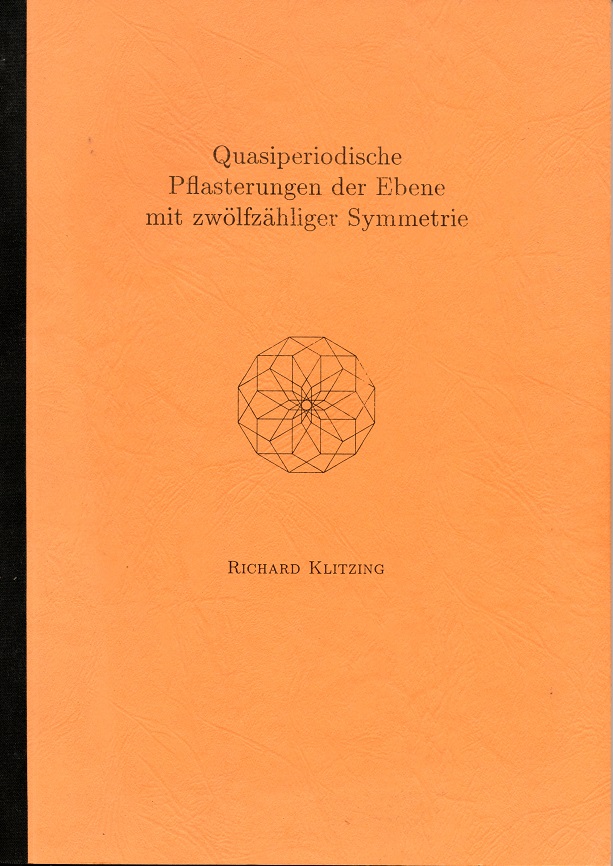
|
|
examina thesis
(german) – so far no download – |
|
Quasiperiodische
Pflasterungen der Ebene mit zwölfzähliger Symmetrie submitted 1992 to: Eberhard Karls Universität Tübingen |
1) Right in those days all convex segmentochora also were modeled by the author as a VRML file each by means of the software Hedron of J. McNeill, which then had been accordingly extended right for their display. This correspondence then also led to the admittance of their display at his website. Until today this is still the only place, where the full set is on display. Even so already most of them meanwhile have been included within this website of the author on the page on segmentotopes.
2) In those days all the found polyhedra (except for the huge class of only trigonal symmetric edge facetings of gidrid) have been modeled by the author as a VRML file each by means of the software Hedron of J. McNeill. Together with an introductory page and a 3-view picture those all are on admitted display at the website of U. Mikloweit. In the meantime however those are accessable via the page ridge facetings on this website as well.
Some technical spreadsheets can be downloaded here as well.
Note that some browsers provide different behaviours, either to open for display directly, or to save into the file system.
The latter one is to be preferred, as else it will be opened in reading modus only.
(Having already opened in reading modus, the viewer usually allows for saving to a local copy too.)
The local copy then clearly is editable. Only then the calculator, painter, etc. can serve their purpose...
-
Circumradius Calculator for Wythoffians –
based on a similar spreadsheet provided by W. Krieger.
Allows to calculate the circumradius of a given Wythoffian polytope directly from its Dynkin symbol: just enter the edge lengths of the edge classes (corresponding to the nodes, e.g. "1" for an "x" and "0" for an "o") in the top row, and the link numbers between those nodes into the triangular matrix below, and you could read off the radius in the cell accordingly labeled.
(A mathematical proof of its underlying formula could be found here.)
Furthermore it also provides the height of lace prisms (for a provided lacing lengths) if the (signed) differences of the edge lengths of the top layer and bottom layer nodes of the respective Dynkin symbol are entered. Then the according height can be read off in the cell which is labeled with "root(l^2-r^2)". – Conversely, if a height is provided (in the lines below), the lacing length of the lace prism then could be read off in the cell which is labeled with "root(h^2+r^2)".
– W. Krieger herself describes its coded content by:" The coordiates you enter for the polytopes are vectors in an oblique coordinate system. The matrix you enter from the dynkin symbol is the 'dynkin' matrix. It is used to calculate the stott matrix, (by simple reciprocal), the stott matrix is used to do a simple dot product between the two vectors. "
Or at an other instance more detailed:" When you take a polyhedron like x5o3x, the 'x' represents a unit edge of the figure. But the coordinates when given are for an edge of 2, eg the cube is ±1, ±1, ±1. So the matrix as given at Klitzing's site actually is set for an edge of 2. In the ordinary symmetry x2x2x, you would use pythagoras to find this, x²+y²+z² = r². Stott's main innovation, and the reason i called it the Stott matrix, is that sliding numbers around, eg to get a rectangular prism (1,2,3), requires motion, and we can capture this motion as a dot product: 1²+2²+3² = 14.
A Stott addition is that x5o3x = x5o3o + o5o3x. In much the same way that (1,2,3) = (1,0,0) + (0,2,0) + (0,0,3). The coordinate system is oblique here, and a vector producing unit height from the plane is longer. For example, what x5o3o includes is the vector (1, f², 0). or (f,f,f). These are the same point, in different symmetry cells. In order to take the dot product of vectors in a oblique system, you might first reduce the vectors to a right-angle system, or invent an entirely new process to take the product direct, This second method produces the 'Stott-matrix', and the 'matrix-dot' product. You won't find much of this in the literature, because mathematicians use the first process. A Stott-matrix contains entries for x5o3o · x5o3o, x5o3o · o5x3o, etc, that is, the dot product of each v(i) · v(j). When you multiply the Stott-matrix by the vertex-vector, and then dot it with the original vector, you get the proper dot product of the vector.
One should note that 'Stott vectors' are not part of the surface. That is 'x5o3o' is not some feature on the surface, but arises at a point outside S2. This is why it works with euclidean and hyperbolic tilings. The Dynkin matrix (i.e. what you are calling the Schläfli matrix), is simply a matrix representation of the CD symbol, and the vertex-vector is the markings on the nodes. The actual Dynkin-matrix is given as the unit normals to the mirrors, so these are the supplement angles. Their cosines, therefore are negative for acute angles and positive for obtuse angles. Clearly the dot product of unit vectors is unit, but we double the whole thing through to produce algebraic integers.
The Stott-matrix for the spheric cases were made by finding the actual vector representing, e.g. x5o3o, o5x3o, and o5o3x. The other cases were created by 'spotting' the matrix. This means, for example, in x4o3o5o, we would calculate the value from the diameter of the verf, and fill that in. Having done all of the single ones, we could find a(1,2), from the value of the verf of x4x3o5o, and so on. All of the finite-content and finite-content groups (para-compact + compact), were done before I realised that the Dynkin-matrix was the magic.
The euclidean cases like x3o6o, end up giving a simple dot vector. The vector gives the correct scaling of edges to the symmetry. For o3o6o, we have (1, 2, h). You dot this with (1,0,0), and the edge is 1. If you dot it with (0,0,1) for o3o6x, you get h. So the o3o6x is h times bigger than x3o6o, but since we use a fixed diameter, the x3o6o has an edge of 1 would make o3o6x 1/h. If you take the spreadsheet at Klitzing's site, and diddle the diagonal, by replacing the '2' with 2+(some cell), and let that cell be either 0 or some tiny value, the second choice will allow you to take the inverse, and you can see these results for yourself.
The complex case works, and this has been done largely by alternate methods (circle-drawing). Note that the matrix gives rise to a radius, and not, say an edge against a fixed sphere. For hyperbolic polytopes, we use the latter.
Schläfli only goes as far as the branches, so his name is used to denote the direct calculation of regular radii using a sequence, starting 1, 2, and then each new member is 2(t-1) + a²(t-2). The product of separate symbols is the product of the Schläfli values. It has a deep connection with the lattice densities.
When we do lace prisms as in Klitzing's matrix, it's simply the 'ladder against the wall problem'. The lattice is pushed out by v(top)-v(bottom), where these are the polytope vectors. You will get negative numbers, but that's ok. Then you calculate the matrix-dot of that, and subtract that from the square of the ladder (i.e. 4e²), and you get the height-squared. It works with a euclidean setting.
Mostly, you can generate the Stott-matrix directly from the Schläfli series, which is how i used to do it before discovering the Dynkin-matrix. I am not sure if this helps. But since the polytope is a vector, and the black&white areas of its symmetry are the equivalent of 'all changes of sign or even changes of sign', the polytope x5o3x gives (1,0,1) in the icosahedral coordinates, and this is the vector 1f0s1. You can then add together a matching dodecahedron and icosahedron, and that gives your coordinates. In a simpler form, when you take the common group EPAC (even permutations, all change of sign), o3o5o gives five sector coordinates.
A lace tower is simply layers of polytope with height as given by the rule above. "As a matter of fact those resulting numbers are provided as floating point numbers, not as algebraic numbers. But then, this is the reason for the lateral columns of numbers within this very spreadsheet: those allow to put in a numerical value and you might be able to resolve it into the form [a + b sqrt(p)]/c for p = 2, 3, or 5: simply insert your floating point number at cell P28, insert a trial value of c into P1 and if some value of the columns M,N,O happens to become integral (which then would be directly spottable) this very value itself would be a while the row index would be b and if the integer would have occured within column M then p=2, if within column N then p=3, or within column O then p=5. For sure, don't try to get out too high values for a, b, c as those mostly would account for close approximants to the originally inserted number only.
-
Circumradius Calculator for Lace Prisms
This excel spreadsheet allows to type in the circumradii of the 2 base polytopes, possibly their additional off-center shifts (if subdimensional), as well as the height of the lace prism, and returns the circumradius of the to be considered lace prism (or segmentotope). In fact this tiny tool just considers 2 parallel hyperspherical sections of an one plus dimensional hypersphere.
-
Circumradius Calculator for Trigonics
This excel spreadsheet allows to type in the circumradii of the 3 base polytopes, possibly their additional off-center shifts (if subdimensional), as well as the mutual pairwise perp-space displacements (i.e. heights of the according lateral lace prisms), and returns the circumradius of the to be considered trigonic. In fact this tiny tool just considers 3 parallel hyperspherical punctures of a two plus dimensional hypersphere, when considered in the 2+n dimensional geometry of lace cities.
-
Circumradius Calculator for Tetrahedrics
This excel spreadsheet allows to type in the circumradii of the 4 base polytopes, possibly their additional off-center shifts (if subdimensional), as well as the mutual pairwise perp-space displacements (i.e. heights of the according pairwise lace prisms), and returns the circumradius of the to be considered tetrahedric. In fact this tiny tool just considers 4 pairwise parallel n-dimensional intersections with a three plus dimensional hypersphere, that is considered in the 3+n dimensional geometry of lace cities as a (general) tetrahedron of position space.
-
OBSA list – a list of Bowers acronyms
(kind of similar to the Index of this website, but might contain entries so far not being contained in here)
-
CRF list – a list of so far known 4D CRFs
(convex & regular faced polychora).
It is sorted by total cell counts and also provides counts by cell type each.
-
Isogon painter –
based on a similar spreadsheet provided by J. McNeill.
Provides a display of semi-regular polygons of symmetry o-n/d-o (up to n=60), right from those given digits n and d. Further contains a slider for the angle between the ray to the seed point and one of the mirrors.
- Small spreadsheet allowing to calculate dihedral angles by providing a set of spanning vertices with their cartesian coordinates.